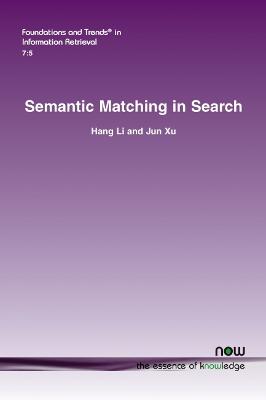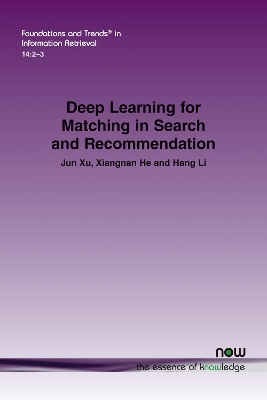Foundations and Trends (R) in Information Retrieval
2 total works
Semantic Matching in Search is a systematic and detailed introduction to newly developed machine learning technologies for query document matching (semantic matching) in search, particularly in web search. It focuses on the fundamental problems, as well as the state-of-the-art solutions of query document matching on form aspect, phrase aspect, word sense aspect, topic aspect, and structure aspect. Matching between query and document is not limited to search, and similar problems can be found in question answering, online advertising, cross-language information retrieval, machine translation, recommender systems, link prediction, image annotation, drug design, and other applications where one is faced with the general task of matching between objects from two different spaces.
The technologies introduced in this monograph can be generalized into more general machine learning techniques, which are referred to as learning to match in this survey. It is hoped that the ideas and solutions explained in Semantic Matching in Search may motivate industrial practitioners to turn the research results into products. The methods introduced and the discussions around them should also stimulate academic researchers to find new research directions and approaches.
The technologies introduced in this monograph can be generalized into more general machine learning techniques, which are referred to as learning to match in this survey. It is hoped that the ideas and solutions explained in Semantic Matching in Search may motivate industrial practitioners to turn the research results into products. The methods introduced and the discussions around them should also stimulate academic researchers to find new research directions and approaches.
Deep Learning for Matching in Search and Recommendation
by Jun Xu, Xiangnan He, and Hang Li
Published 14 July 2020
Matching, which is to measure the relevance of a document to a query or interest of a user to an item, is a key problem in both search and recommendation. Machine learning has been exploited to address the problem and efforts have been made to develop deep learning techniques for matching tasks in search and recommendation. With the availability of a large amount of data, powerful computational resources, and advanced deep learning techniques, deep learning for matching now becomes the state-of-the-art technology for search and recommendation.
The key to the success of the deep learning approach is its strong ability in learning of representations and generalization of matching patterns from data. This survey gives a systematic and comprehensive introduction to the deep matching models for search and recommendation. First, it gives a unified view of matching in search and recommendation and the solutions from the two fields can be compared in one framework. Then, the survey categorizes the current deep learning solutions into two types: methods of representation learning and methods of matching function learning. The fundamental problems as well as the state-of-the-art solutions of query-document matching in search and user-item matching in recommendation are described.
Deep Learning for Matching in Search and Recommendation aims to help researchers from both search and recommendation communities to get an in-depth understanding and insight into the spaces, stimulate more ideas and discussions, and promote developments of new technologies. As matching is not limited to search and recommendation, the technologies introduced here can be generalized into a more general task of matching between objects from two spaces.
The key to the success of the deep learning approach is its strong ability in learning of representations and generalization of matching patterns from data. This survey gives a systematic and comprehensive introduction to the deep matching models for search and recommendation. First, it gives a unified view of matching in search and recommendation and the solutions from the two fields can be compared in one framework. Then, the survey categorizes the current deep learning solutions into two types: methods of representation learning and methods of matching function learning. The fundamental problems as well as the state-of-the-art solutions of query-document matching in search and user-item matching in recommendation are described.
Deep Learning for Matching in Search and Recommendation aims to help researchers from both search and recommendation communities to get an in-depth understanding and insight into the spaces, stimulate more ideas and discussions, and promote developments of new technologies. As matching is not limited to search and recommendation, the technologies introduced here can be generalized into a more general task of matching between objects from two spaces.

